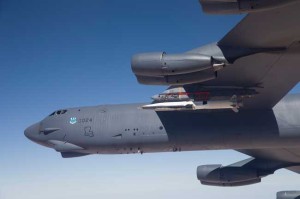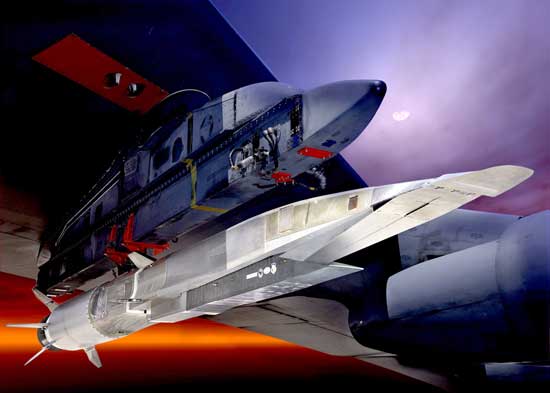The fourth and final flight of theBoeing X-51A Waverider test program has accomplished a breakthrough in the development of flight reaching Mach 5.1 over the Pacific Ocean May 1. The WaveRider unmanned hypersonic vehicle traveled more than 230 nautical miles in just over six minutes over the Point Mugu Naval Air Warfare Center Sea Range, Calif.
It was the longest air-breathing, scramjet-powered hypersonic flight in history, flying for three and a half minutes on scramjet power at a top speed of Mach 5.1. The vehicle flew for a total time of more than six minutes. Charlie Brink, the X-51A program manager for the Air Force Research Laboratory Aerospace Systems Directorate described the test as “full mission success”. It was the last of four test vehicles originally conceived when the $300 million technology demonstration program began in 2004. The program objective was to prove the viability of air-breathing, high-speed scramjet propulsion.

The X-51A Waverider prepares to launch its historic fourth and final flight. The cruiser achieved Mach 5.1 traveling 230 nautical miles in just over six minutes, making this test the longest air-breathing hypersonic flight ever. (U.S. Air Force photo/Bobbi Zapka)
“This demonstration of a practical hypersonic scramjet engine is a historic achievement that has been years in the making,” said Darryl Davis, president, BoeingPhantom Works. “This test proves the technology has matured to the point that it opens the door to practical applications, such as advanced defense systems and more cost-effective access to space.”
A U.S. Air Force B-52H Stratofortress from Edwards Air Force Base released the X-51A from 50,000 feet above the Point Mugu Naval Air Warfare Center Sea Range at 10:55 a.m. Pacific time. After the B-52 released the X-51A, a solid rocket booster accelerated the vehicle for about 26 seconds to Mach 4.8 before the booster and a connecting interstage were jettisoned. After separating from the booster, the cruiser’s supersonic combustion ramjet, or scramjet, engine then lit and accelerated the aircraft to Mach 5.1 at 60,000 feet. After exhausting its 240-second fuel supply, the vehicle continued to send back telemetry data until it splashed down into the ocean and was destroyed as designed. At impact, 370 seconds of data were collected from the experiment. The X-51A made a controlled dive into the Pacific Ocean at the conclusion of its mission.
The X-51A is unique primarily due to its use of JP-7 hydrocarbon jet fuel in its scramjet engine. Other vehicles have achieved hypersonic, generally defined as speeds above Mach 5, flight with the use of hydrogen fuel. Without any moving parts, hydrocarbon fuel is injected into the scramjet’s combustion chamber where it mixes with the air rushing through the chamber and is ignited in a process likened to lighting a match in a hurricane.
“I believe all we have learned from the X-51A Waverider will serve as the bedrock for future hypersonics research and ultimately the practical application of hypersonic flight,” Brink said. As a technology demonstration program, there is no immediate successor to the X-51A program. However, the Air Force will continue hypersonic research and the successes of the X-51A will pay dividends to the High Speed Strike Weapon program currently in its early formation phase with AFRL.
Aviation Week Guy Noris added: “The success of the flight, which included 240-seconds of powered flight in scramjet mode – the longest ever achieved by an air-breather, is particularly important to the Air Force as it seeks to develop a hypersonic capability. Interest in high-speed, long range strike weapons which can fly at hypersonic speeds grew in the 2000s with the requirement to prosecute fleeting targets in counter-terrorism operations, and is assuming fresh importance with the strategic ‘pivot’ to Asia.”
Noris added this last flight incorporated improvements and lessons learned from the three former flights. These included better sealing between interfaces in the engine flow-path, hardware and software changes and redesign of the control fins.
The X-51A program is a collaborative effort of the Air Force Research Laboratory and the Defense Advanced Research Projects Agency, with industry partners Boeing and Pratt & Whitney Rocketdyne. Boeing performed program management, design and integration in Huntington Beach, Calif.
sumber : defence update

No comments:
Post a Comment